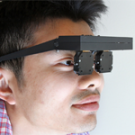Near-Eye Light Field Displays

We propose near-eye light field displays that enable thin, lightweight head-mounted displays (HMDs) capable of presenting nearly correct convergence, accommodation, binocular disparity, and retinal defocus depth cues. Sharp images are depicted by out-of-focus elements by synthesizing light fields corresponding to virtual objects within a viewer's natural accommodation range. We formally assess the capabilities of microlens arrays to achieve practical near-eye light field displays. Building on concepts shared with existing integral imaging displays and light field cameras, we optimize performance in the context of near-eye viewing. We establish fundamental trade-offs between the quantitative parameters of resolution, field of view, and depth of field, as well as the ergonomic parameters of form factor and ranges of allowed eye movement. As with light field cameras, our design supports continuous accommodation of the eye throughout a finite depth of field; as a result, binocular configurations provide a means to address the accommodation-convergence conflict occurring with existing stereoscopic displays. We construct a complete prototype display system, comprising: a custom-fabricated HMD using modified off-the-shelf parts and real-time, GPU-accelerated light field renderers (including a general ray tracing method and a "backward compatible" rasterization method supporting existing stereoscopic content). Through simulations and experiments, we motivate near-eye light field displays as thin, lightweight alternatives to conventional near-eye displays.
Publication Date
Research Area
Uploaded Files
Copyright
Copyright by the Association for Computing Machinery, Inc. Permission to make digital or hard copies of part or all of this work for personal or classroom use is granted without fee provided that copies are not made or distributed for profit or commercial advantage and that copies bear this notice and the full citation on the first page. Copyrights for components of this work owned by others than ACM must be honored. Abstracting with credit is permitted. To copy otherwise, to republish, to post on servers, or to redistribute to lists, requires prior specific permission and/or a fee. Request permissions from Publications Dept, ACM Inc., fax +1 (212) 869-0481, or permissions@acm.org. The definitive version of this paper can be found at ACM's Digital Library http://www.acm.org/dl/.
